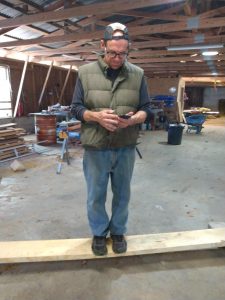Case(s) in Point
In the example (here) I discussed a person standing on a wood plank, and `examining’ the deflection. Talk is cheap. I grabbed three pieces of lumber (that I milled) in my shop: one piece a 1 x 5 Southern Pine (SP), a second piece 1.5 x 8 SP, and a third piece 1 x 4 Eastern Red Cedar (ERC). And stood on them, midspan, while Linda measured deflections. Now note that while the setups were very much `real’, they would not be applicable to typical building construction; I laid the pieces flatwise, so to get deflections that I could feel, see, and be easily measured. In a typical building we would want just the opposite: we would want deflections to be hardly see-able, measurable but small, and we definitely would not want to feel the deflections (sag). But it’s still the same `E’ (for the most part) … here goes!

The deflection of a beam (plank, board, joist, etc.) due to the action of a concentrated load at midspan is …
Δ = P L3 / (48 E I)
where
P = the load (say a person)
L = beam (plank, etc.) span (distance between supports)
E = Modulus of Elasticity (E, `Eeee’, MOE)
I = Area Moment of Inertia of the `beam’ = b d 3 / 12.
For `P’ … I used myself, clothed, and carrying, my cell phone (pictured), … 192 lb;
L = see each plank;
48 … a number based on beam curvature theory, the only number in this whole exercise that is `exact’;
E = see below; and
I = see each plank.
For E … I selected:
For the SP pieces, which, incidentally, were cut from the same log, merely inches from each other … E presumed = 1,300,000 psi (NDS Supplement, No. 3 and Stud; there were big knots!)
For the ERC … E presumed = 880,000 psi (Wood Handbook, MC 12%, beautiful wood, with only a few tiny knots)
Here is the specific plank data, calculated (theoretical) deflections, measured deflections, and back-calculated (actual) E values.
Board Number ONE
Southern Pine (1 x 5)
P = 192 lb
b = 4.94 in.
d = 0.844 in.
L = 60 in. (5 feet)
E presumed = 1,300,000 psi
Δ calculated (based on presumed E) = 2.69 in.
Δ actual (measured) = 2.81 in.
E actual (from actual Δ) = 1,243,000 psi
(E actual is 4% low of presumed)
Board Number TWO
Southern Pine (1½ x 8)
P = 192 lb
b = 8.0 in.
d = 1.56 in.
L = 84 in. (7 feet)
E presumed = 1,300,000 psi
Δ calculated (based on presumed E) = 0.717 in.
Δ actual = 0.75 in.
E actual (from actual Δ) = 1,243,000 psi
(E actual is 4% low of presumed)
Board Number THREE
Eastern Red Cedar (1 x 4)
P = 192 lb
b = 3.94 in.
d = 0.875 in.
L = 36 in. (3 feet)
E presumed = 880,000 psi
Δ calculated (based on presumed E) = 0.965 in.
Δ actual = 0.875 in.
E actual (from actual Δ) = 970,000 psi
(E actual is 10% HIGH of presumed)
Discussion
That the actual E’s for the Pine pieces turned out exactly the same (to 5 significant figures) is remarkable (1,242,951 psi and 1,242, 990 psi), particularly since nothing else was measured (is even measurable) to that accuracy.
That the SP actual E’s were low of published did not surprise me; I was a bit surprised they were as close as they were!
That the ERC E actual was higher did not surprise me; the Cedar was indeed beautiful wood, with few small knots.
One might argue (correctly) that I should be using `shear-free’ E for my planks. Indeed, the L/d ratios for these tests was LARGE. For large L/d the effects of shear contrastingly go away. Per NDS Appendix F, I could back out an approximate shear component deflection by increasing the published values by 3%. In that case the SP actual E’s would be more like 7 or 8% low of published, and the ERC E would be closer … to within about 7%.
One more thing: the Moisture Content (MC) of the ERC was 5-ish%; the SP 11-15%. MC has a role to play in E, and other structural properties of wood. Did that have a role in the actual SP E’s being lower and presumed, and the E actual for ERC being higher? Quite perhaps! Does it matter?
Finally, what about dead load deflection? The planks had already deflected due to their own weights (not much), before I climbed on, and set up `zero’ on the `gauges’. Thus, the measured deflections were due to `P’ only.